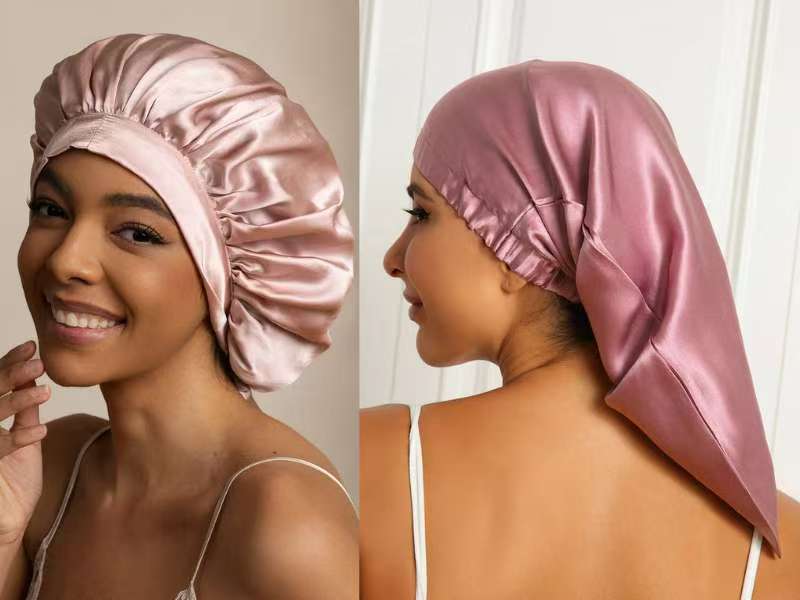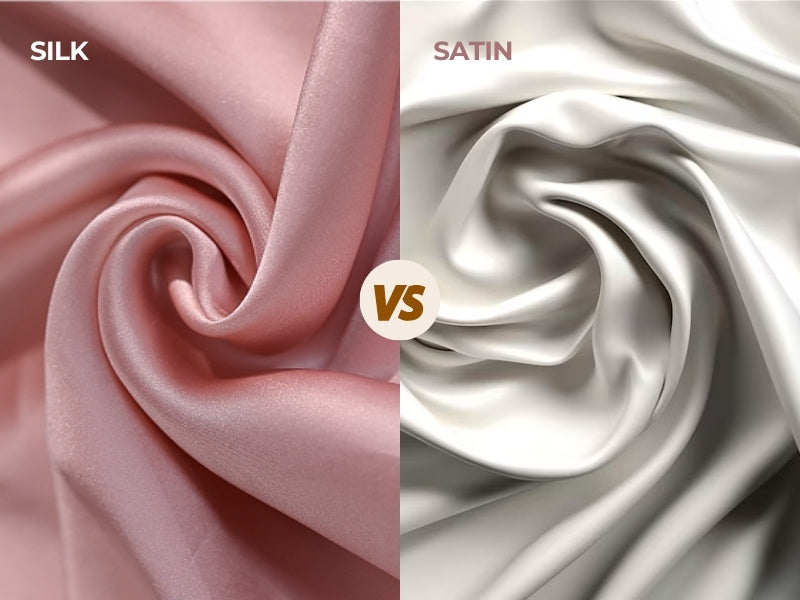Uses Of Silk In Food, Chemical Engineering & Biomedicine Industry

The mulberry silk, tussah silk , and celestial silk are precious animal natural fibers. They have the advantages of slenderness and uniformity, toughness, lightness and softness, heat resistance and insulation, breathability and moisture absorption, bright luster, moderate elasticity, and good dyeability. Has always been high-end traditional textile materials. In recent years, with the continuous advancement of science and technology, the research and development of new silk materials and new uses have been continuously strengthened.
1. Food and chemical materials
1.1 Silk food additives
(1) The nature of silk food additives
Silk is composed of silk fibroin, sericin, silk wax, sugar, pigments and inorganic substances. The two proteins of silk fibroin and sericin account for about 97% of the total weight of silk. In silk fibroin and sericin, the former accounts for 70% to 75%, and the latter accounts for 22% to 24%. The main amino acids in silk are Gly, Ala, Ser and Tyr, which account for about 85% of the total amino acids in silk. However, these major amino acids are non-essential amino acids or semi-essential amino acids, so from this perspective, silk is not superior sex. However, further studies have shown that certain special amino acids or silk peptides (peptides obtained from incomplete acid hydrolysis or enzymatic hydrolysis of silk fibroin) have unique medical or health benefits: reducing blood cholesterol levels, preventing high blood pressure, cerebral thrombosis, and old age. Dementia and stroke, etc.; promote insulin secretion, assist in the treatment of diabetes, relieve alcohol and protect the liver; regulate immunity. In addition, sericin also has a certain potential application value in the prevention and treatment of malignant tumors.
The amino acid composition of silk
| Amino acid | Mulberry Silk | Tussah Silk | Celestial silk | Note | |||
| silk
% |
Silk Fibroin % | Sericin
% |
Silk mol
% |
Silk Fibroin
% |
Silk Fibroin
% |
||
| Gly | 30 .77 | 38 .04 | 8 .53 | 30 .43 | 25 .85 | 21 .06 | |
| Ala | 22 .89 | 25 .15 | 3 .97 | 43 .15 | 44.11 | 39 .20 | |
| To be | 14.65 | 13.07 | 29 .86 | 10.80 | 12.89 | 6 .89 | |
| Tyr | 11 .35 | 12.27 | 3 .77 | 3 .07 | 9 .01 | 5 .84 | |
| Asp | 5.04 | 1 .42 | 16.67 | 5 .20 | 8 .22 | ||
| Glu | 1 .92 | 1 .24 | 10.62 | 1 .04 | 2 .12 | 2 .02 | |
| List | 1 .10 | 0.36 | 5 .75 | 0 .13 | 0 .21 | 0 .13 | Essential amino acids |
| Thr | 2.75 | 0.98 | 5 .16 | 0 .42 | 0 .47 | 0 .50 | Essential amino acids |
| His | 0.64 | 0.36 | 1 .39 | 0 .49 | 1 .56 | 0 .14 | Semi-essential amino acid |
| Val | 2.93 | 2.58 | 1 .88 | 0 .88 | 1 .52 | Essential amino acids | |
| Leu | 0.92 | 0.89 | 0 .89 | 0 .40 | 0 .40 | 0 .35 | Essential amino acids |
| With | 1 .37 | 1 .15 | 6 .75 | 0 .41 | 0 .38 | 0 .42 | Essential amino acids |
| Arg | 1 .56 | 0.71 | 4 .07 | 2 .62 | 5 .13 | Semi-essential amino acid | |
| Pro | 0.46 | 0.44 | 0 .53 | 0 .47 | 1 .58 | ||
| Phe | 1 .01 | 0.98 | 0 .69 | 0 .35 | 0 .47 | Essential amino acids | |
| Trp | 0.46 | 0.27 | 1 .75 | Essential amino acids | |||
| Met | 0.18 | 0.09 | 0 .04 | 0 .50 | 0 .15 | Essential amino acids | |
| Cys | 0.03 | 0 .04 | 0 .23 | ||||
(2) Research and development of silk food
Silk fibroin powder and silk peptide are the main forms of silk food additives. The silk nutrient and silk peptide developed in Zhejiang Province have been proved by relevant medical departments to have a significant effect on reducing blood sugar and lipid. Zhou Fengjuan and others used waste cocoon silk as raw material to obtain food-grade soluble silk fibroin powder after impurity removal, refining, dissolution, desalination by dialysis, and spray drying. Jin Shaohei researched the production technology of silk peptide functional beverage and silk peptide chewing (containing) tablets. Liu Ying and others prepared a hangover and liver-protecting drink with tussah silk as the main raw material. Japan has also successfully developed silk fibroin candies, jellies, biscuits and soy sauce, among which the amount of silk fibroin powder added is 2%-50%. In the past, sericin was generally thrown away as a waste product, but Japanese scholars discovered that sericin not only partially replenishes amino acids, but also promotes the absorption of mineral elements such as Zn, Fe, Mg, and Ca, so it is also a valuable food additive. Sericin used in food and cosmetics fields is mainly low molecular weight (≤20kD) sericin peptide.
At present, silk is widely used in the food industry. In the research and development process of silk food additives, it is necessary to combine theories and experimental techniques such as toxicology, physiology, biochemistry, genetics, etc., to strengthen the identification and research of the health benefits of silk health foods, and to prevent exaggerated health benefits and rush without approval. Phenomena such as listing occurred.
1.2 Silk cosmetic additives
(1) The nature of silk cosmetic additives
According to traditional Chinese medicine records, natural silk can eliminate dark spots on the skin and treat certain purulent skin diseases. Modern research shows that silk has the following advantages:
- Silk contains all essential amino acids and semi-essential amino acids, and almost no allergenic substances;
- The silk peptide molecule is in a random coiled conformation, the peptide chain is loose and disordered, and many polar hydrophilic groups are exposed, so it is a natural moisturizing factor;
- Silk has good UV absorption and sun protection functions. According to scholars from the International Wild Sericulture Society, the transmittance of mulberry silk to UV-A zone (wavelength 320-400nm) and UV-B zone (wavelength 280-320nm) are 37.7% and 18.4%, respectively, while tussah silk is only 18.1%. And 5.6%. S Zhaorigetu et al. found that sericin can significantly reduce UV-B burns in mice and reduce the incidence of UV-B-induced tumors;
- Silk protein has good compatibility with other cosmetic raw materials;
- Sericin can inhibit tyrosinase activity;
- In vitro experiments confirmed that sericin can inhibit lipid peroxidation.
(2) Research and development of silk cosmetics
It is precisely because of the excellent nutrition, moisturizing, sun protection, and anti-oxidation functions of silk that make the development of silk cosmetic additives very fast. Silk skin creams, cosmetic lotions and creams developed in South Korea have been put on the market. Silk shampoos and hair dyes developed in Japan are also on the market. China has also successfully developed silk protein cream, silk peptide protein milk, and silk peptide shampoo.
1.3 Synthetic fiber modified materials
As we all know, synthetic fibers tend to have poor moisture absorption and release properties and are prone to static electricity. Therefore, the clothes made of synthetic fibers are not as comfortable as natural fibers. However, if the synthetic fiber is impregnated with the modified sericin solution or the modified sericin solution is directly coated on the synthetic fiber fabric, the water absorption of the fabric can be improved, the amount of static electricity of the fabric can be reduced, and a certain antibacterial effect can be produced. Using this coating technology, Japan has developed modified synthetic fiber underwear, undershirts, diapers and bedding.
1.4 Biodegradable plastic modified materials
Biodegradable plastics are environmentally friendly materials with broad development prospects, but its promotion and application are restricted by many factors, and poor mechanical properties are one of the common problems. In order to improve the mechanical and thermodynamic properties of polybutene succinate plastics, Lee SM et al. studied the influence of the amount of silk fiber addition on the related properties of the plastic. The study found that the appropriate addition of silk fiber can significantly improve the mechanical properties and thermomechanical properties of the plastic. Stability (but failed to significantly enhance thermal stability).
2. Biomedical materials
Silk is very similar to human keratin, collagen, etc., and has good biocompatibility with the human body, so it has been used as a surgical suture very early. In recent years, the application of silk in biology and medicine has become more extensive and in-depth.
2.1 Tissue engineering materials
A large number of studies have shown that silk has unique conditions in the fields of tissue engineering and clinical repair:
- Good biocompatibility, non-toxic, non-irritating, and cause less inflammation. Meinel L et al. believe that the inflammatory response of silk membrane is equal to or lower than that of collagen membrane.
- High tensile strength and elasticity.
- Water and oxygen permeability are high.
- Conducive to cell adhesion and growth.
- The preparation process of silk material is simple and convenient.
- Silk is easily available in large quantities.
- Silk fibroin can be slowly absorbed by the human body or partially biodegraded, and the degradation products have no toxic side effects on tissues. Meinel L et al. found that silk fibroin has good mechanical properties and is an excellent scaffold for bone tissue engineering. In-depth research has found that the texture of silk fibroin fiber affects its application in biomedicine. Silk fibroin nanofiber membrane is more suitable as a tissue engineering scaffold than silk fibroin film and silk fibroin microfiber. Silk fibroin nanofiber membrane can better guide rabbit skull regeneration.
2.2 New medical materials
In recent years, research on the use of silk in artificial blood vessels, artificial skin, artificial tendons or ligaments, anticoagulant drugs, disease diagnosis sensors and other fields has been very active. Horan RL et al. confirmed that silkworm silk has high mechanical strength and long degradation cycle, and is suitable as a substitute for tendons or ligaments. Tamada Y et al. found that the anticoagulant activity of sulfated sericin is about 1/10 to 1/20 of heparin. Silk fibroin film has a good application prospect in covering and protecting burns or other skin wounds, but its water solubility and mechanical properties after regeneration are often not stable enough. In view of this, Lu Qiang et al. [ 20 ] optimized the preparation process of the silk fibroin film, and the obtained insoluble pure silk fibroin film has excellent wet mechanical properties, and the tensile strength and elongation at break can reach 15.9 MPa and 49.4%, respectively. . HofmannS et al. used dextran, horseradish peroxidase, and lysozyme as test materials to prove that silk fibroin film has a higher feasibility in polysaccharide and protein drug coating. Katayama et al. confirmed through in vitro and in vivo experiments that silk fibroin can be used as a good sustained-release carrier for theophylline drugs. Compared with traditional organic coating technology, silk fibroin film-coated tablets are easy to prepare, do not pollute the environment, are harmless to the human body, and have promising development prospects.
2.3 Enzyme engineering materials
In enzyme engineering, silk can be used as a carrier for enzyme immobilization. Using sericin as an immobilized enzyme carrier can significantly improve the heat resistance, electroosmotic resistance and stability of the enzyme. Covalently attaching L-asparaginase to sericin particles, the Km value of the immobilized enzyme obtained is 8 times lower than that of the non-immobilized enzyme of the control, the optimal reaction temperature range is greatly expanded, and the resistance to trypsin is also Significantly enhanced. In addition, sericin is also used as an immobilized carrier for glucosidase and glucose oxidase. Zhu Xiangrui et al. found that the operating half-life of immobilized glucose isomerase with silk fibroin as a carrier was significantly extended, and the ability to resist urea was also significantly improved. Zhang YQ et al. covalently linked L-glutaminase to water-soluble silk fibroin, which significantly enhanced the thermal stability of the enzyme, prolonged the half-life by 30 hours, and significantly reduced the immunogenicity and antigenicity of the enzyme, and the interaction between the enzyme and the substrate The affinity is significantly improved. In addition, silk fibroin can also be used as an immobilized carrier for amylase, glucose oxidase, catalase, pectinase, amylase, glucoamylase, sucrase, lipase and SOD.
2.4 Bioreactor
The silkworm bioreactor is an important research direction in the field of bioengineering in recent years. In theory, it is feasible to use genetic engineering methods to make silkworms spit out high-grade medicinal proteins (such as interferon and vaccines). Zhejiang University has successfully developed a method for preparing biological products using the silkworm bioreactor, which has been used in the large-scale production of a genetic engineering drug.
It needs to be emphasized that when silk is used in the fields of food, cosmetics, medicine and bioengineering, attention must be paid to the safety of silk materials. At present, it is generally believed that silk protein is non-toxic to the human body and contains almost no allergens. Heavy metals and other organic substances that may be harmful to the human body are usually only attached to the sericin, which can be completely removed by degumming or other special processes. Relevant scientific research institutions believe that silk fibroin is a non-toxic substance through food toxicology tests.
3. Light Industrial Materials
3.1 Silk paper
Silk paper and cocoon paper are new paper-type protein materials that do not damage the morphology of silk fibers. They have excellent reprocessing properties and have important uses in the fields of food preservation, indoor formaldehyde pollution control, trimethylamine adsorption, and drug carriers. Li Weixian et al. studied the process of making silk paper by wet method, and produced silk paper with excellent adsorption, air permeability, water resistance, mechanical strength and reworkability.
3.2 Air purification materials
In addition to the form of silk paper, silk can also be used for indoor air purification in the form of some artificially simulated enzyme scaffolds or carriers. The artificial mimetic enzyme-silk complex ( CO2 P C2 CSF, C o F e P C2 CSF) prepared by Yao YY et al . can effectively eliminate the odor of CH 3 SH and H 2 S.
3.3 Electrical insulation materials
People have long discovered that silk has electrical insulation properties, and based on this, electrical insulation products such as silk safety belts, arc suppression ropes, and insulating ladders have been developed. Using silk as the main material, Hao Xudong and others have developed insulating ropes for live working with strong moisture-proof properties, which can be used safely under conditions such as high humidity and even dampness, water immersion, and rain.
4. Summary
In fact, in addition to the above-mentioned new materials, new uses of silk are still expanding. For example, silk can also be used in the fields of anti-frost materials for refrigeration equipment, cement slurry additives for oil fields, fixatives for saline sandy soils, biosensors, and bioenzyme protectors. A Japanese company recently reported a contact lens made of silk fibroin with a refractive index of 1.69.
It can be predicted that the research and development of new silk materials will not only benefit the development of the material industry, but also is expected to promote the progress of the silk industry and other related industries. In the future, the research and development of new silk materials should be continued.
In the research and development process of new silk materials, the following issues should be paid attention to:
- Not only need to extensively study new silk materials and new uses, but also actively try pilot and large-scale trials, and finally realize industrialized production
- In the research and development process of silk food and chemical materials, low-level duplication should be avoided. For example, although many units have developed silk-based food additives and cosmetic additives, few of them are actually on the market on a large scale. Investigate the reason, low-level repeated research is a reason that cannot be ignored;
- The research, production and application of new silk materials is a complex system engineering involving multiple disciplines, and it is often difficult to complete it successfully by relying solely on one discipline. For example, although sericin is a promising synthetic fiber modified material, it is almost impossible to realize the industrialization of sericin-like synthetic fiber modified materials only by textile or dyeing and finishing. It must also rely on biology, chemical engineering, materials and other disciplines. Collaboration and cooperation. It is necessary to strengthen the joint research of related disciplines, and strive to put more new silk materials into production practice.
![[Light Blue] SilkSilky Pure Silk Notch Collar Women's Pajamas 001,](http://silksilky.com/cdn/shop/files/ab83afb9301666ee2f174a8ae72ffda4_4e9bb488-7880-40fe-9e69-f0fd823857c5.jpg?v=1764653199&width=1200)
![[Light Blue] SilkSilky Pure Silk Notch Collar Women's Pajamas 002,](http://silksilky.com/cdn/shop/files/db8dbeee5354fe3b631b963715847ffe.jpg?v=1764653202&width=1200)
![[Dark Blue] SilkSilky 19Momme Pure Silk Notch Collar Women's Pajamas 001](http://silksilky.com/cdn/shop/files/a3a1bba736f86048192bee870ad3e638_be7e8977-dfbe-4235-87ac-1471e906d5e9.jpg?v=1763547174&width=1200)
![[Dark Blue] SilkSilky 19Momme Pure Silk Notch Collar Women's Pajamas 002](http://silksilky.com/cdn/shop/files/3a1b158868225840e725562c4d5c7c9c_50e1a43d-6284-4def-9c49-bb64a6300eee.jpg?v=1763547174&width=1200)
![[Pink] SilkSilky Pure Silk Sleep Cap 001,](http://silksilky.com/cdn/shop/files/SilkSilky_Pure_Silk_Sleep_Cap_Pink_001_C-250529006.jpg?v=1762221980&width=1200)
![[Pink] SilkSilky Pure Silk Sleep Cap 002,](http://silksilky.com/cdn/shop/files/SilkSilky_Pure_Silk_Sleep_Cap_Pink_002_C-250529006.jpg?v=1762221980&width=1200)
![[White] SilkSilky Pure Silk V Neck Nightgown 001,](http://silksilky.com/cdn/shop/files/a8ae95260a57844b1e2e00c4fcfabdcc_b922b270-af10-4e96-9493-0d877bd663db.jpg?v=1764140639&width=1200)
![[White] SilkSilky Pure Silk V Neck Nightgown 002,](http://silksilky.com/cdn/shop/files/24ac506750f8c38c51bb5b6d0ee15287.jpg?v=1764140639&width=1200)
![[Dark Red] SilkSilky Pure Silk Notch Collar Women's Pajamas 001,](http://silksilky.com/cdn/shop/files/599ed0811e1a5fcfa55bdc80a0279704_2643c850-a793-4475-a52b-7fef1bbd7e36.jpg?v=1762233837&width=1200)
![[Dark Red] SilkSilky Pure Silk Notch Collar Women's Pajamas 002,](http://silksilky.com/cdn/shop/files/9e022d4dd4f99aed4af8da3f58fcfd5b_efb9bafe-3d71-4283-9b81-e339ff08f352.jpg?v=1762233837&width=1200)







